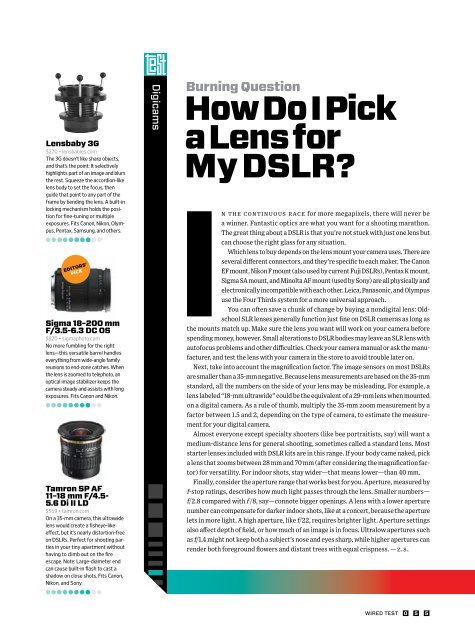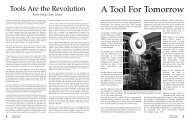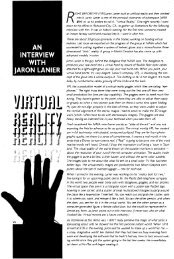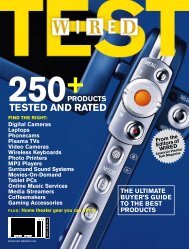You also want an ePaper? Increase the reach of your titles
YUMPU automatically turns print PDFs into web optimized ePapers that Google loves.
Lensbaby 3G<br />
$270 • lensbabies.com<br />
The 3G doesn’t like sharp objects,<br />
and that’s the point: It selectively<br />
highlights part of an image and blurs<br />
the rest. Squeeze the accordion-like<br />
lens body to set the focus, then<br />
guide that point to any part of the<br />
frame by bending the lens. A built-in<br />
locking mechani<strong>sm</strong> holds the position<br />
for fine-tuning or multiple<br />
exposures. Fits Canon, Nikon, Olympus,<br />
Pentax, Samsung, and others.<br />
EDITORS’<br />
PICK<br />
Sigma 18–200 mm<br />
F/3.5-6.3 DC OS<br />
$820 • sigmaphoto.com<br />
No more fumbling for the right<br />
lens—this versatile barrel handles<br />
everything from wide-angle family<br />
reunions to end-zone catches. When<br />
the lens is zoomed to telephoto, an<br />
optical image stabilizer keeps the<br />
camera steady and assists with long<br />
exposures. Fits Canon and Nikon.<br />
Tamron SP AF<br />
11–18 mm F/4.5-<br />
5.6 Di II LD<br />
$569 • tamron.com<br />
On a 35-mm camera, this ultrawide<br />
lens would create a fisheye-like<br />
effect, but it’s nearly distortion-free<br />
on DSLRs. Perfect for shooting parties<br />
in your tiny apartment without<br />
having to climb out on the fire<br />
escape. Note: Large-diameter end<br />
can cause built-in flash to cast a<br />
shadow on close shots. Fits Canon,<br />
Nikon, and Sony.<br />
Digicams<br />
Burning Question<br />
HowDoIPick<br />
aLensfor<br />
MyDSLR?<br />
In the continuous race for more megapixels, there will never be<br />
a winner. Fantastic optics are what you want for a shooting marathon.<br />
The great thing about a DSLR is that you’re not stuck with just one lens but<br />
can choose the right glass for any situation.<br />
Which lens to buy depends on the lens mount your camera uses. There are<br />
several different connectors, and they’re specific to each maker. The Canon<br />
EF mount, Nikon F mount (also used by current Fuji DSLRs), Pentax K mount,<br />
Sigma SA mount, and Minolta AF mount (used by Sony) are all physically and<br />
electronically incompatible with each other. Leica, Panasonic, and Olympus<br />
use the Four Thirds system for a more universal approach.<br />
You can often save a chunk of change by buying a nondigital lens: Oldschool<br />
SLR lenses generally function just fine on DSLR cameras as long as<br />
the mounts match up. Make sure the lens you want will work on your camera before<br />
spending money, however. Small alterations to DSLR bodies may leave an SLR lens with<br />
autofocus problems and other difficulties. Check your camera manual or ask the manufacturer,<br />
and test the lens with your camera in the store to avoid trouble later on.<br />
Next, take into account the magnification factor. The image sensors on most DSLRs<br />
are <strong>sm</strong>aller than a 35-mm negative. Because lens measurements are based on the 35-mm<br />
standard, all the numbers on the side of your lens may be misleading. For example, a<br />
lens labeled “18-mm ultrawide” could be the equivalent of a 29-mm lens when mounted<br />
on a digital camera. As a rule of thumb, multiply the 35-mm zoom measurement by a<br />
factor between 1.5 and 2, depending on the type of camera, to estimate the measurement<br />
for your digital camera.<br />
Almost everyone except specialty shooters (like bee portraitists, say) will want a<br />
medium-distance lens for general shooting, sometimes called a standard lens. Most<br />
starter lenses included with DSLR kits are in this range. If your body came naked, pick<br />
a lens that zooms between 28 mm and 70 mm (after considering the magnification factor)<br />
for versatility. For indoor shots, stay wider—that means lower—than 40 mm.<br />
Finally, consider the aperture range that works best for you. Aperture, measured by<br />
f-stop ratings, describes how much light passes through the lens. Smaller numbers—<br />
f/2.8 compared with f /8, say—connote bigger openings. A lens with a lower aperture<br />
number can compensate for darker indoor shots, like at a concert, because the aperture<br />
lets in more light. A high aperture, like f/22, requires brighter light. Aperture settings<br />
also affect depth of field, or how much of an image is in focus. Ultralow apertures such<br />
as f/1.4 might not keep both a subject’s nose and eyes sharp, while higher apertures can<br />
render both foreground flowers and distant trees with equal crispness. —z.s.<br />
WIRED TEST<br />
0 5 5








